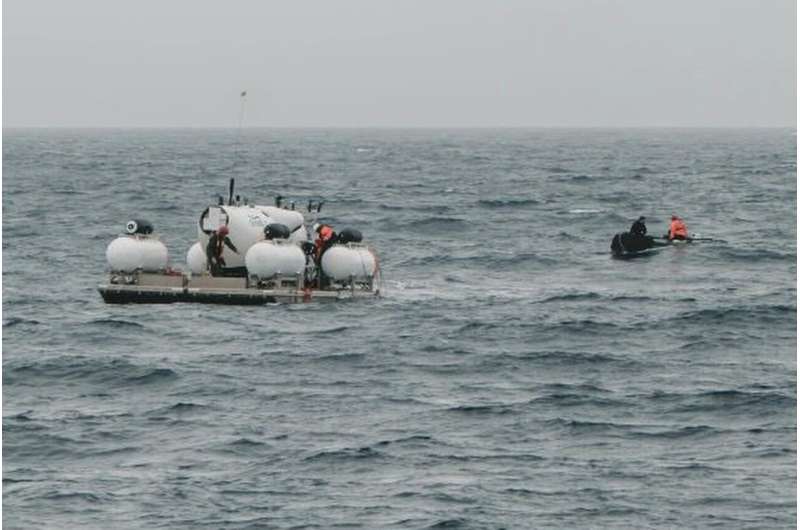This article has been reviewed according to Science X's editorial process and policies. Editors have highlighted the following attributes while ensuring the content's credibility:
fact-checked
reputable news agency
proofread
Did initial delays in communication hamper tourist sub search?

Eight hours. And within them, many unanswered questions.
About an hour and a half after it dipped below the North Atlantic, a submersible on an expedition to view the wreckage of the Titanic lost communication with the surface Sunday. It would take another nearly eight hours before the Canadian research icebreaker Polar Prince, supporting the Titan submersible, reported it missing to the Coast Guard—a report that triggered an intense international rescue effort.
The time lag has yet to be explained by the company that owns the submersible, OceanGate Expeditions. But it may not have mattered—The U.S. Coast Guard said Thursday the vessel imploded near the wreckage of the Titanic, killing all five people on board.
Coast Guard Rear Adm. John Mauger said it was too soon to say whether the implosion happened at the time of last communication. But it was not detected by sonar buoys used by search crews, he said, which suggests it happened before they arrived.
"We had listening devices in the water throughout and did not hear any signs of catastrophic failure from those," he said.
Sean Leet, head of the company that co-owns the Titan's support ship, refused to discuss the timeline during a news conference Wednesday, saying only that "all protocols were followed for the mission." But experts familiar with deep-sea exploration said those lost hours raise red flags.
"The time delay between declaring a submersible sunk and notification to outside resources and emergency responders appears to be excessive," said Robert Kraft, a deep-sea explorer who has located missing ships in the ocean. The emergency procedure in question, he said, is typically declared after three consecutive scheduled communications are missed "but can vary slightly between organizations."
Others suggested the delay could have been due to the unorthodox approach taken by the company behind the experimental vessel.
Salvatore Mercogliano, a history professor at Campbell University in North Carolina who focuses on maritime history and policy, said the people on the Polar Prince likely didn't call for help after losing communication with the Titan because the submersible had previously experienced communication failures—so such an occurrence didn't raise immediate alarms. The vessel used a rudimentary system that basically communicated with the surface ship through text message, Mercogliano said.
"They've lost communications before. And so what it appears is when they lost communications, they did not assume that this was a disaster at all," Mercogliano said.
"They probably were waiting for what was would have been the end of the scheduled voyage. And they probably waited for the period when they expected the Titan to come back to the surface," he speculated. "They were unable to locate it. And then they knew they had an emergency."
Another thing to consider: Mercogliano said the Titan lacked an emergency radio beacon that could have floated to the surface and started beeping if there was an emergency. "But they didn't have that," he said. "And so it sounds like the Polar Prince waited the normal period of time for the recovery of this submersible to send out the mayday in distress."
Norman Polmar, a prominent naval analyst and author, said the protocol for "checking in" would be set by the company, and it varies by company and submersible. A company may say to check in every four hours and check in immediately if there's a problem, but there are absolutely no set rules with commercial submersibles, he added.
"From a military viewpoint, there are specific protocols. But from a commercial one, there is nothing that's standard," he said Thursday. "If they said nine hours, that might have been what their agreement was— if we don't have a problem, we'll call you in nine hours. For civilian submersibles, it's what they want. Within the military, if you have got an experiment or test or trials, yes there is a fixed protocol."
Aaron Davenport, a maritime expert, senior policy researcher with the RAND Corporation and a retired U.S. Coast Guard officer, said he's been perplexed by the operation's perceived lack of safety protocols given the inherent dangers, including the timing of when Polar Prince sent out its distress call.
First of all, Davenport said, the Titan and Polar Prince should have had a procedure in place in which they stayed in periodic contact, such as every hour or so.
"The protocol that is normally used in the Coast Guard operations, and in any kind of potentially dangerous situation, is that you want to maintain communications with someone on the surface or ashore that can call for help or render assistance in the event of an emergency," Davenport said.
"And so you would think they would check in with the surface on a regular basis," Davenport said. "And then if you don't hear from them, then that would be an indication that you may need to start thinking about a potential rescue or getting things staged or invoke a plan, if you are unable to determine if they are safe or not."
Davenport added that most ships carry an emergency beacon, which is automatically deployed if the ship sinks. But he said he's seen no indication that the Titan had a way to alert anyone of an emergency situation.
In an email after an Associated Press interview, Davenport added that the vessel that launched the submersible appeared incapable of rescuing the vessel.
"They lost several hours early on—they should have started alerting folks and preparing for a rescue immediately," Davenport said. "What is confounding is that they lost comms with the sub at the beginning of the mission, and it does not seem they had a good plan to restore comms and/or abort the mission."
© 2023 The Associated Press. All rights reserved. This material may not be published, broadcast, rewritten or redistributed without permission.





















